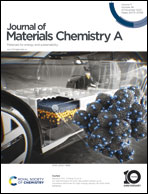Nitrogen-rich porous organic cages with high acetylene storage and separation performance†
Abstract
Searching for porous materials that can safely store and efficiently separate acetylene (C2H2), a commonly used petrochemical feedstock with highly explosive properties, is a pressing and significant task. Nitrogen-rich porous materials have garnered substantial attention for their ability to interact strongly with acidic C2H2. Herein, we report two novel nitrogen-rich porous organic cages (POCs), namely CPOC-107 and CPOC-203, constructed from the same bowl-shaped tetraformylcalix[4]resorcinarene but different nitrogen-rich imidazolium-based diamine synthons. X-ray crystallographic analysis reveals that CPOC-107 adopts a [2 + 4] lantern-shaped structure, whereas CPOC-203 takes on a [3 + 6] triangular prism shape. Moreover, the cages exhibit large cavity volumes of up to 787 Å3 and high specific surface areas of up to 1202 m2 g−1. Owing to their high surface areas and high nitrogen content, both cages exhibit impressive C2H2 adsorption capabilities. Specifically, CPOC-107 achieves a remarkable C2H2 uptake value of up to 146 cm3 g−1 at 298 K and 1 atm, the highest among those reported for all porous organic materials to date. Moreover, experimental breakthrough tests have confirmed the effective separation of C2H2/CO2 mixtures using the CPOC-107 adsorbent.

- This article is part of the themed collection: Functional Framework Materials


 Please wait while we load your content...
Please wait while we load your content...